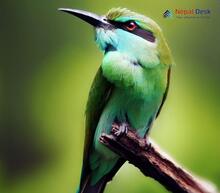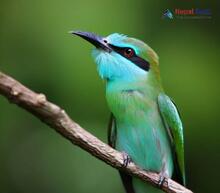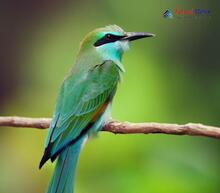Nepal, a nation nestled amidst the towering Himalayas, boasts a remarkable variety of flora and fauna. Its diverse landscape, ranging from subtropical lowlands to alpine forests, creates a breathtaking natural sanctuary for many species. Among these species lies a lesser-known yet captivating genus of birds, the Nyctyornis. Here, we will take an enlightening journey through Nepal's wildlife profile to learn more about the intriguing Nyctyornis genus.
Diving into the World of Nyctyornis
The Nyctyornis genus is composed of two fascinating bird species: Blue-bearded Bee-eater (Nyctyornis athertoni) and Red-bearded Bee-eater (Nyctyornis amictus). Sporting their eponymous beards, these bee-eaters possess distinctive color patterns that make them stand out from other avian creatures.
Blue-bearded Bee-eater (Nyctyornis athertoni)
As suggested by its name, this species has striking blue feathers around its throat that resemble a beard. Found in the central and eastern parts of Nepal, it thrives in subtropical or tropical moist lowland forests and degraded former forests. Their diet primarily consists of insects such as bees, wasps, butterflies, and dragonflies.
Red-bearded Bee-eater (Nyctyornis amictus)
The Red-bearded Bee-eater sports an equally vibrant color pattern as its blue sibling. It has a reddish-brown beard with a vivid green upper body plumage. Preferring subtropical or tropical moist montane forests bordering rivers or streams, it is found in central and eastern Nepal. This species also preys on various insects including bees, wasps, and butterflies.
Exploring Nepal's Efforts to Preserve Its Wildlife
Nepal has made commendable strides in the field of conservation to protect its captivating wildlife. In addition to national parks and wildlife reserves, the country has established buffer zones and community-based conservation approaches. These efforts create a sanctuary for lesser-known species like the Nyctyornis genus, contributing to preserving biodiversity.
For those interested in observing these remarkable birds in their natural habitat, joining a guided wildlife tour or birdwatching expedition may help heighten the chances of coming across members of the Nyctyornis genus. Local tour guides can provide valuable insight into spotting these birds while minimizing disturbance to their environment.
By delving into Nepal's thriving wildlife profile, we gain a deeper appreciation for the myriad of species that call this breathtaking region home. As we continue to learn more about enigmatic birds like the Nyctyornis genus and other fauna found within Nepal's borders, we may unlock more secrets that contribute to the beauty and wonder of this unique country. So let's treasure our planet's diversity by celebrating the alluring Nyctyornis genus and encouraging efforts to preserve Nepal's rich and vibrant wildlife heritage.




